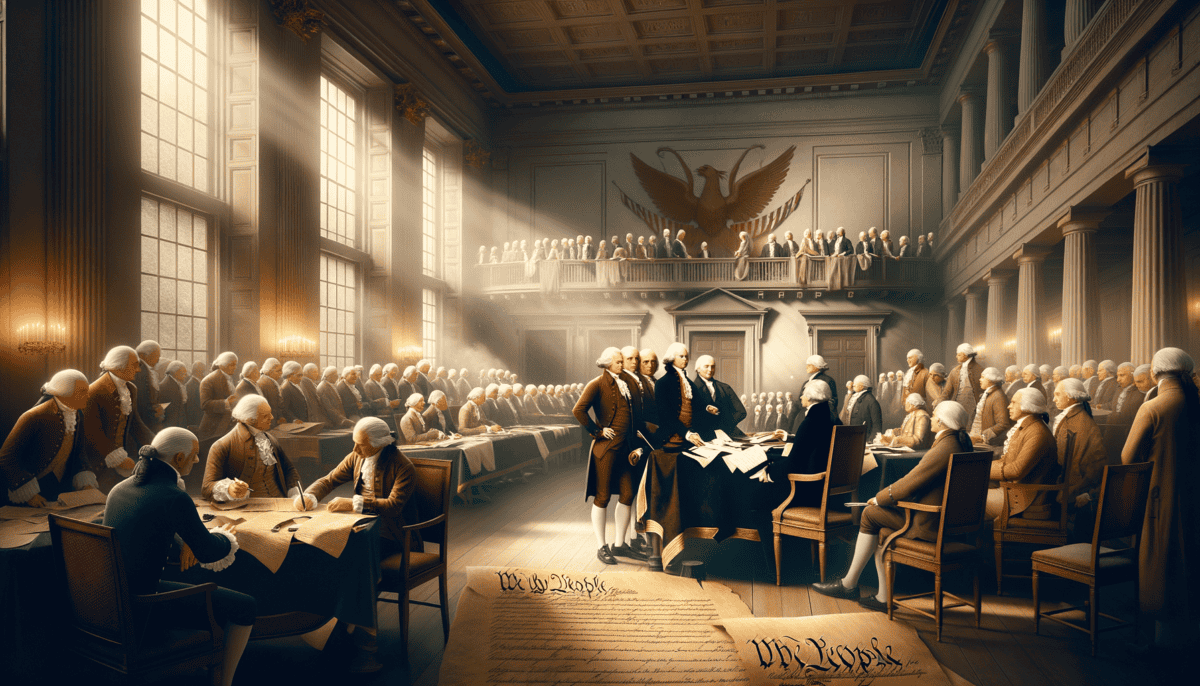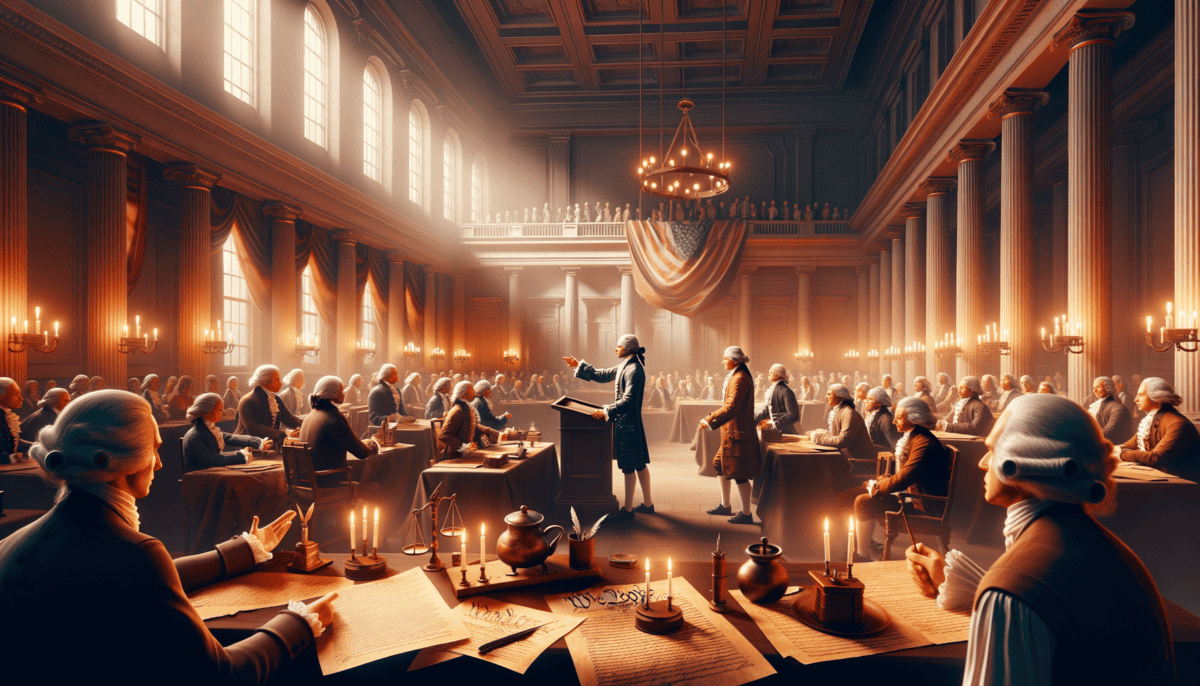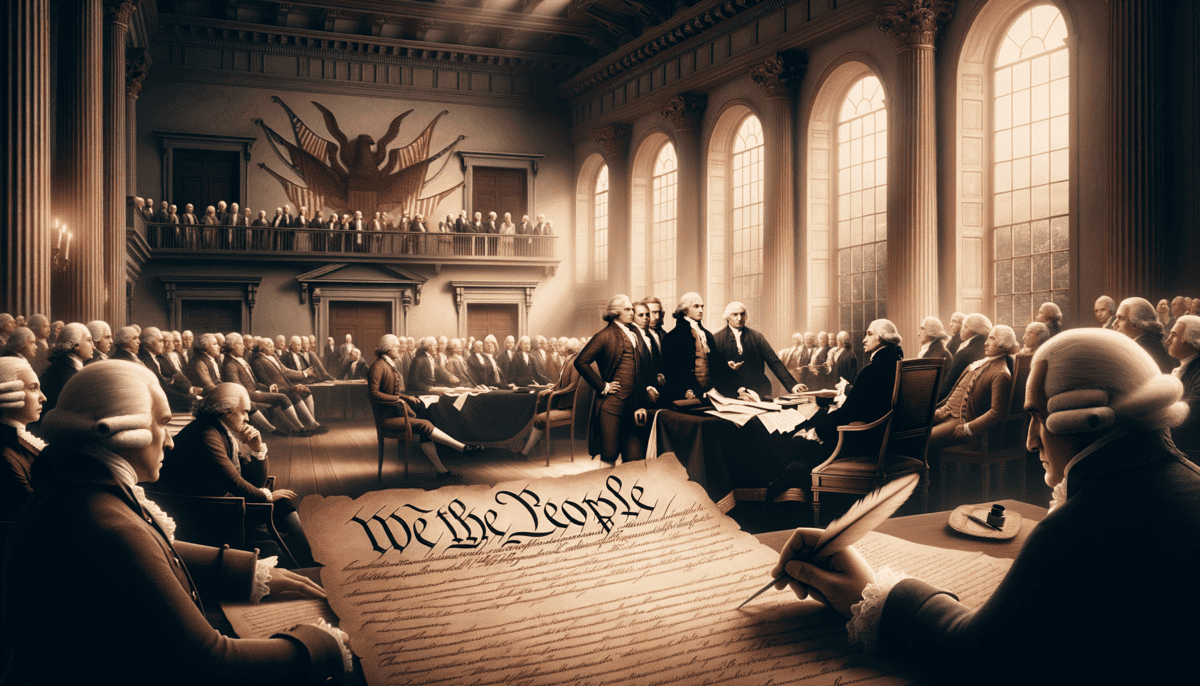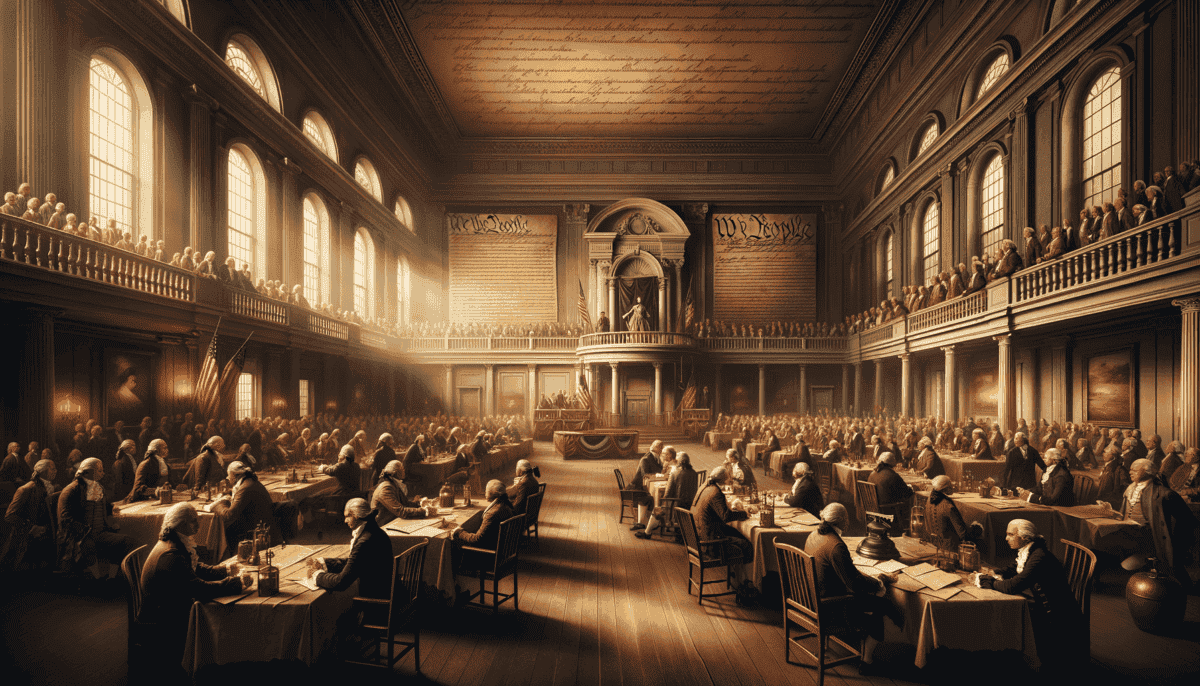The Summer of Change
The hot sun beat down on Philadelphia's cobblestone streets as James Madison wiped sweat from his brow. It was May 1787, and something big was about to happen.
"We must fix our country," Madison whispered to himself as he climbed the steps of Independence Hall. The tall building with its red brick walls and white tower would become home to one of the most important meetings in history.
George Washington sat in a special chair at the front of the room. His face looked worried. The country was having big problems. Each state had its own money and rules. It was like having thirteen different mini-countries instead of one big family.
"My friends," Washington's deep voice filled the room. "We are here to make our country stronger."
Madison nodded. He had spent months planning for this day. He wanted to create new rules that would help everyone work together better. But not everyone agreed on what those rules should be.
The Big Problems
"The small states feel scared," said a man from Delaware. "They think the big states will boss them around!"
"And we big states want fair treatment too!" shouted someone from Virginia.
Madison wrote everything down in his notebook. He knew they needed to find ways to make everyone happy. It was like trying to get all your friends to agree on one game to play at recess – not easy!
Some days were really hard. The room was so hot that they had to keep the windows closed to keep their talks secret. Benjamin Franklin, who was 81 years old, had to be carried to the meetings in a special chair!
Hope for Change
But Madison didn't give up. Every night, he wrote down new ideas. He thought about ways to make the government work better:
- Each state would send people to help make decisions
- The country would have one president instead of thirteen different leaders
- Everyone would use the same kind of money
As the sun set on that first day, Madison looked around the room at all the important people there. They came from different places and had different ideas, but they all wanted to help make America better.
"Tomorrow is another day," he thought, closing his notebook. "Together, we can fix this."
The warm evening air carried the sounds of Philadelphia's busy streets through the windows. Big changes were coming, and James Madison knew this was just the beginning of an amazing story.
A Plan Takes Shape
The morning sun streamed through Independence Hall’s tall windows as Alexander Hamilton paced the wooden floor. His mind was racing with ideas.
“We need a strong government!” Hamilton’s voice echoed through the chamber. “But how do we make it fair for everyone?”
• A part to make laws
• A part to enforce laws
• A part to judge laws
Benjamin Franklin sat quietly in his chair, watching the younger men debate. His eyes twinkled with wisdom earned from 81 years of life. “Perhaps,” he said softly, “we need to think like a family.”
The Great Puzzle
“What do you mean, Dr. Franklin?” asked a curious delegate.
“In a family, everyone has different jobs. Parents make rules, children follow them, and together they solve problems. Our government should work the same way!”
Hamilton’s face lit up. “Yes! We could have Congress make laws, like parents setting rules. The president would make sure people follow the laws, like an older sibling helping out. And judges would solve arguments, like parents settling disputes!”
Finding Balance
The room grew quiet. This was a tricky problem. Big states like Virginia wanted more power because they had more people. Small states like Delaware wanted equal power so they wouldn’t get pushed around.
“I have an idea!” Roger Sherman jumped up from his seat. “What if we make Congress have two parts?”
Everyone leaned in to listen.
“In one part, states get representatives based on how many people they have. In the other part, every state gets the same number of representatives – just two!”
Hamilton smiled as he watched the delegates nodding in agreement. They were finally starting to work together, like pieces of a puzzle fitting into place.
“We’re building something special,” Franklin said, his eyes twinkling. “Something that will last for many years to come.”
As the summer sun began to set, the delegates kept working. They were creating a new kind of government – one that would be strong enough to unite the country but fair enough to protect everyone’s rights.
Outside, children played in the streets of Philadelphia, not knowing that inside Independence Hall, a group of determined men were creating something that would change their lives forever.
Difficult Choices
The hot summer air filled Independence Hall as Roger Sherman wiped sweat from his forehead. Today would be a hard day. The delegates needed to talk about something that made everyone uncomfortable – slavery.
James Wilson stood up, his voice firm but kind. “We must decide how to count people for representation in Congress. Should we count everyone? Or just free people?”
Two Sides of the Story
“The South has many enslaved people,” said a delegate from Georgia. “If we don’t count them at all, we’ll have less power in Congress.”
“But they can’t vote,” argued a delegate from Massachusetts. “How can we count people who aren’t allowed to have a say in government?”
The room grew tense. Some delegates shifted uncomfortably in their chairs. Others whispered to their neighbors.
Finding Another Way
James Madison picked up his quill pen. “What if we counted three out of every five enslaved persons? It’s not perfect, but it might help us move forward.”
No one was completely happy with this idea. But they knew they had to agree on something. This became known as the Three-Fifths Compromise.
Checking and Balancing
“Now,” Wilson said, changing the subject, “we need to make sure no part of our government becomes too powerful.”
“Like three legs on a stool!” Benjamin Franklin called out. “If one leg gets too long, the whole thing tips over!”
• Congress could say no to the president
• The president could say no to Congress
• Judges could say laws were wrong
“I like this idea,” said another delegate. “It’s like having three friends watch each other to make sure everyone plays fair at games.”
As the day went on, the delegates created more rules about how the different parts of government would work together. Some would be chosen by the people. Others would be picked by state leaders.
A Light in the Dark
The sun was setting when Wilson finally sat down. His hand hurt from writing so much. But he felt proud. Even when things got hard, they kept working together.
Outside, fireflies began to twinkle in the growing darkness. Inside, candles burned as the delegates continued their important work. They knew that what they were doing would help build a better future for everyone. ✨
Tomorrow would bring new challenges. But for now, they had made progress. Step by step, they were building something that had never been tried before – a government that would work for all the states together.
A Nation Divided
The autumn leaves swirled around Patrick Henry as he stood before a crowd in Virginia. His eyes blazed with passion. “They want us to accept this new Constitution,” he called out. “But is it safe for our freedoms?”
Friends and Foes
In New York, John Jay dipped his quill in ink. He was writing letters to help people understand why the Constitution was good. His friends Alexander Hamilton and James Madison were writing too.
“Dear Friends,” Jay wrote, “Our new Constitution will make us stronger together. But some people are scared of change.”
State by State
Delaware said yes to the Constitution first. They were happy to be part of something bigger. Pennsylvania and New Jersey followed quickly.
But in other states, people weren’t so sure. In Virginia, Patrick Henry kept speaking against it.
“What about our rights?” he asked. “Where does it say the government can’t take away our freedoms?”
Making It Better
Many people agreed with Patrick Henry. They wanted the Constitution to say exactly what rights people had.
• Speaking freely
• Having their own religion
• Being treated fairly by the law
Working Together
“What if we promise to add these rights later?” James Madison suggested. “We can make them the first changes to the Constitution.”
This made many people feel better. They started calling these promised changes the Bill of Rights.
Victory at Last
One by one, more states said yes. New Hampshire became the ninth state to agree, which meant the Constitution would now work!
Even Virginia and New York finally said yes, though they still worried. They trusted that James Madison would keep his promise about adding the Bill of Rights.
Back in Philadelphia, bells rang out to celebrate. People danced in the streets. After all the arguing and worry, they had done it! The United States had a new plan for its future. ⭐
But there was still work to do. They needed to write down all those rights they had promised to protect. The story of making America better was just beginning.
Protecting Our Rights
James Madison sat at his desk, surrounded by stacks of papers. The morning sun streamed through his window as he wrote carefully. He had a big job to do – writing down the rights that would protect all Americans. ✍️
Making a Promise Real
“We must keep our word,” Madison said to his friend Thomas Jefferson. “People trusted us to protect their freedoms.”
Jefferson nodded. “What rights should we write down first?”
Writing the Rights
Madison worked hard to make each right clear and strong. He wanted everyone to understand them, even kids!
• Freedom to speak and write
• Freedom to pray
• Freedom to meet with friends
• Freedom to ask the government to fix problems
• Right to be treated fairly by the law
Getting Everyone to Agree
“These rights are good,” said some people in Congress. “But we need more!”
Madison listened to everyone’s ideas. He knew it was important to make the Bill of Rights perfect.
“What about protecting people’s homes?” someone asked.
“Yes!” Madison agreed. “The government shouldn’t be able to search homes without a good reason.”
Making It Official
After lots of talking and changing words around, Congress liked what Madison wrote. Now the states needed to say yes too. ️
State by state, people read the Bill of Rights. They thought about what it meant for them and their families. Many liked how it protected them from a government becoming too strong. ️
A Happy Day
Finally, enough states said yes! The Bill of Rights became part of the Constitution. People celebrated knowing their freedoms were now protected in writing.
Thomas Jefferson smiled at his friend Madison. “You did it! You helped make America even stronger.”
“We all did it together,” Madison replied. “And these rights will protect Americans forever.” ⭐
But the story wasn’t over. As America grew, people would find new rights to protect and new ways to make the country better for everyone.
A Document That Grows With Us
The sun rises over the Supreme Court building in Washington, D.C. Inside, nine judges work to understand what our Constitution means today. Just like a tree that grows taller and stronger, our Constitution keeps growing too!
New Rights for New Times
“How does a document written so long ago still help us today?” asked Sarah, a young student visiting the Supreme Court.
Justice Roberts smiled at Sarah. “The Constitution is like a living tree. It grows as our country grows. Let me show you some important changes we’ve made.”
Making America More Fair
Through the years, brave Americans helped make the Constitution better for everyone:
• Susan B. Anthony fought for women to vote
• Martin Luther King Jr. worked for equal rights
• Many others stood up for what’s right
The Constitution Today
“Our Constitution protects new things too,” Justice Roberts explained. “Like your privacy when you use a computer or phone!”
Sarah’s eyes widened. “Really? But they didn’t have phones back then!”
“That’s right,” he replied. “We use the Constitution’s ideas to solve new problems. It’s like using an old recipe but adding new ingredients.” ⚖️
Everyone’s Job
Sarah thought about this. “Even kids like me?”
“Especially kids like you! You’re learning about your rights and responsibilities. That’s how we keep our democracy strong.”
Looking Forward
As Sarah left the Supreme Court, she felt proud. She understood now that the Constitution wasn’t just an old piece of paper. It was alive with the dreams and hopes of all Americans.
“What changes will we make next?” she wondered. “Maybe someday I’ll help make the Constitution even better!”
And so, the story of our Constitution continues. Each generation adds their own chapter, making sure this amazing document grows and changes just like America itself. It’s not just history – it’s our story, and we’re still writing it together.






